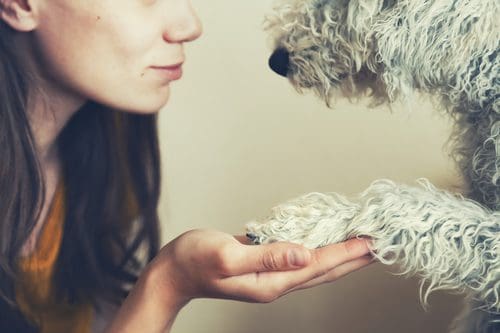
Dogs, our faithful companions for thousands of years, watch our every move. And, it seems, have the ability to copy some of the things we do.
When author of Do As I Do: Using Social Learning to Train Dogs Claudia Fugazza found out that her dog knew how to turn on the bathroom tap, she was convinced that her canine pal had learned to do this through observation.
Reported by the American Kennel Club, Fugazza commented: “From a scientific perspective, imitation requires some complex cognitive skills. However, dogs can do it, thanks in part to domestication.”
Look and learn
The theory is that, just like children, dogs who grow up in a complex human social world adopt a 'look and learn' approach. This idea was put to the test by a group of biologists and psychologists at the universities of Vienna and Oxford, who collaborated to design an experiment to test if dogs do have a ‘social’ capacity to copy what they see.
Using a simple wooden box, 10 owners showed their dogs how to open it, sometimes using their heads to push a handle and sometimes using their hands. In the first part of the test, five dogs were rewarded with a piece of sausage for copying their owners' actions. The other five were rewarded with food for not copying and using the alternative method. With each dog the experiment was repeated several times, and the time taken for a dog to get it 'right' on 85% of attempts (17 goes out of 20) was recorded. The dogs encouraged to mirror their owners reached this point almost three times sooner than those rewarded for not copying them.
In the second part of the test, all the dogs were only rewarded for copying the method their owner used. The five dogs previously rewarded for copying their owners reached the 85% mark more than twice as quickly as the other five.
Do as I do
It’s compelling evidence and reveals just how much influence our own behaviour has on our dogs. Commenting on the study in The Telegraph, Caroline Kisko from The Kennel Club said: "The findings confirm what many owners and people involved with dogs have known for years. A dog’s behaviour is influenced much like that of a child; through socialisation, learning right from wrong and adopting similar patterns of behaviour. We hope that owners understand the importance of their actions and use this knowledge to set good examples and therefore positively influence the behaviour of their pets."
Help your dog become a copycat
To see how responsive your dog is copycatting, why not try out the training methods Claudia Fugazza outlines in her book. Called ‘Do as I Do,’ the process works like this:
- Choose three behaviours that your dog can do solely with a verbal cue — no hand signal or other gesture required. These need to be behaviours you can do, too – so probably not jumping through a hoop or squeezing through a pop-up tunnel!
- Use those behaviours to teach your dog a general command that means ‘copy me. Fugazza uses ‘do it’. For example, say you’ve chosen ‘spin’, first have your dog stay then do the spin yourself. Immediately afterwards, say ‘do it’ to your dog, followed by ‘spin’. If your dog spins, reward them.
- As you do this repeatedly for the three different behaviours in random order, your dog will start anticipating, and offer up the behaviour before you say ‘spin’. Once that happens, start dropping the old command.
- When your dog can successfully perform the three chosen behaviours just by watching you and hearing the command ‘do it’, you know that your dog is copying you. You can use this to teach your dog new things.
Fugazza stresses that this technique isn’t meant to replace other training methods, but to supplement them. She says: “I would never use ‘Do as I Do’ to teach actions like walking on leash or recall,” she says. “But complex and goal-oriented actions can be trained more quickly this way.” And just imagine what fun can be had in the process!
If you found this interesting, you may also like:
- In praise of praising your dog
- Brush up on your dog park etiquette
Sources: akc.org, telegraph.co.uk














